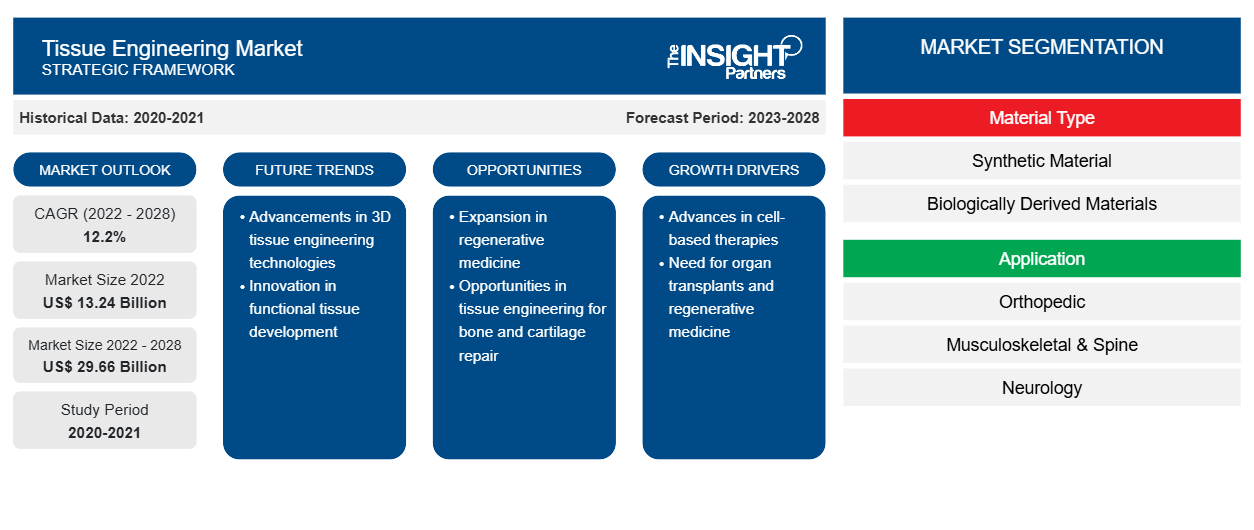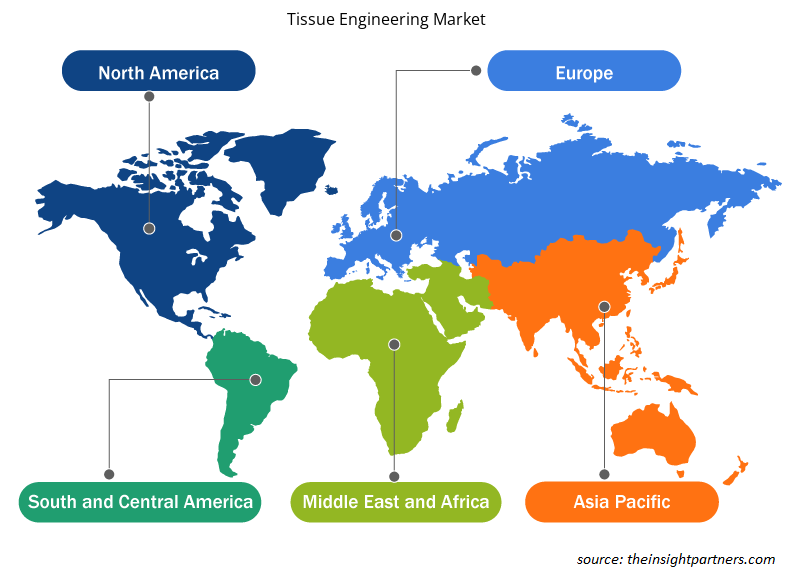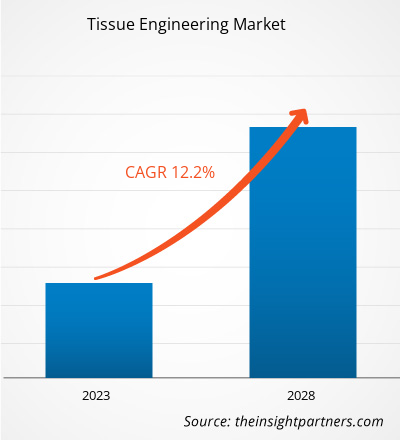[Research Report] The tissue engineering market is expected to reach US$ 13,236.87 million in 2022 and is projected to touch US$ 29,659.93 million by 2028. It is expected to grow at a CAGR of 12.2% from 2022 to 2028.
Tissue engineering is a biomedical engineering discipline that uses a combination of cells, engineering, material methods, and appropriate biochemical and physicochemical factors to regenerate, preserve, enhance, or replace various types of biological tissues. Tissue Engineering (TE) is a rapidly evolving discipline that aims to repair, replace, or regenerate tissues or organs by converting fundamental physics, chemistry, and biology knowledge into practical and effective materials or devices and clinical strategies.
Tissue engineering has several primary functions in medicine and research: Assisting in tissue or organ repair, including bone repair (calcified tissue), cartilage tissue, heart tissue, pancreatic tissue, and vascular tissue. The field also researches the behavior of stem cells. Stem cells can develop into many different cell types and help repair areas of the body. The 3D nature of tissue engineering allows the study of tumor architecture in a more detailed environment. It also provides an environment to test potential new drugs for these diseases. Growth in the number of R&D activities with increasing awareness of tissue engineering in emerging markets is expected to support the market growth. Developed nations have adopted technological advances in tissue engineering and regenerative medicine that contribute to expanding the global tissue engineering market
The scope of the global tissue engineering market includes material type, application, and geography. The market for tissue engineering is analyzed based on regions such as North America, Europe, Asia Pacific, Middle East & Africa, and South & Central America. The report offers insights and in-depth analysis of the global tissue engineering market emphasizing on various parameters such as market trends, technological advancements, market dynamics, and competitive landscape analysis of leading market players across the globe.
Customize This Report To Suit Your Requirement
You will get customization on any report - free of charge - including parts of this report, or country-level analysis, Excel Data pack, as well as avail great offers and discounts for start-ups & universities
Tissue Engineering Market: Strategic Insights

- Get Top Key Market Trends of this report.This FREE sample will include data analysis, ranging from market trends to estimates and forecasts.
You will get customization on any report - free of charge - including parts of this report, or country-level analysis, Excel Data pack, as well as avail great offers and discounts for start-ups & universities
Tissue Engineering Market: Strategic Insights

- Get Top Key Market Trends of this report.This FREE sample will include data analysis, ranging from market trends to estimates and forecasts.
Market Insights
Increasing Number of Road Accidents and Trauma Injuries, and Elevating Incidence of Chronic Diseases
The rising incidence of chronic diseases and increasing number of trauma injuries and road accidents are prime factors contributing to the market's growth for advanced treatment procedures, such as tissue engineering. Road accidents are among the major fatalities worldwide as they cause serious injuries to bones and organs. As per the WHO, ~20–50 million people get injured every year in road accidents. Tissue engineering offers alternatives to surgical reconstruction, transplantation, and mechanical device instruction to repair damaged tissues. The global tissue engineering market is mainly driven by a continuous need for effective regenerative treatments to treat increasing cases of diabetes, obesity, and other disorders caused by lifestyle changes, expanding geriatric population, and a rising number of trauma cases.
A spinal cord injury (SCI) refers to damage to the spinal cord that temporarily or permanently changes its function. According to the Multidisciplinary Digital Publishing Institute (MDPI), an estimated 3 million people live with traumatic SCI worldwide, with approximately 180,000 new cases reported each year. SCI often results in devastating, long-lasting neurological deficits, manifesting as dysfunction of the motor, sensory, or autonomic nervous systems below the level of injury. To thoroughly repair or regenerate damaged tissues or organs and restore their functions has been a dream of humans. The advent of Tissue Engineering and Regenerative Medicine (TERM) seems to make this possible. Tissue engineering combines cells, scaffolds, and growth factors to regenerate tissue or replace damaged or diseased tissue.
Cancer is among the leading causes of mortality worldwide, and the disease affects a huge population. Therefore, it acts as a huge financial burden on society. According to the WHO, in 2018, ~9.6 million deaths occurred due to cancer globally. However, growing research on developing effective treatments for the disease is positively impacting the market growth. Gene therapy and cell therapy are transforming the cancer treatment landscape; for example, Novartis Kymriah is used to treat diffuse large B-cell lymphoma. The launches of more such products would drive the demand for cell and gene therapy, thus fueling the global tissue engineering market in the coming years.
Material Type-Based Insights
Based on material type, the global tissue engineering market is segmented into synthetic material, biologically derived materials, and others. In 2022, the biologically derived materials segment is expected to lead the market. A biomaterial plays a significant role in the development of tissue engineering and biomedical devices that naturally increase the regenerative potential of tissues to restore body mechanism, in a state of deterioration. Biologically derived materials are used in creating neo-tissues in vitro that are identical to their fundamental body parts. These materials also help in tissue regeneration by a controlled presentation and on-demand release of specific chemokines at sites of injury, tissue-resembling structural, temporary biodegradable support matrices with natural and functional characteristics. However, the synthetic material segment is likely to register highest CAGR in the global tissue engineering market during the forecast period.
Application-Based Insights
Based on application, the global tissue engineering market is segmented into orthopedic, musculoskeletal & spine, neurology, cardiology & vascular, skin & integumentary, urology, GI & gynecology, cancer, and others. The orthopedic, musculoskeletal & spine segment is expected to lead the market in 2022. However, the skin & integumentary segment is anticipated to register the highest CAGR in the market during the forecast period.
Ever since severe acute respiratory syndrome coronavirus 2 (SARS-CoV-2) was declared a public health emergency of international concern in late January 2020, medical professionals and researchers have been urging the need for comprehensive and rapid testing of citizens to plan measures that can contain the spread of the virus. COVID-19 pandemic has become the most significant challenge across the world. This challenge was frightening especially in developing countries across the globe as it will lead to reducing imports due to disruptions in global trade. Till date no definitive treatment against COVID 19 has been established. Hence, lack of definitive therapy offers significant opportunities for tissue engineering market as US FDA has recently approved use of plasma therapy for critically ill COVID 19 patients. Over time, real-time polymerase chain reaction tests and antibody tests have emerged as vital techniques for the global healthcare system to manage the outbreak. The supply chain disruptions, along with the enormous demand for effective diagnostics as well as therapeutics for the treatment of COVID 19 had put healthcare research industry in critical situation in various regions. Risks were majorly on emerging markets that face healthcare constraints and tighter financial conditions. The COVID-19 pandemic also hampered clinical trials, drug development, and the diagnostics industry's operation in the region. Also, significant disruptions to routine research activities involving tissue engineering and regenerative medicines were also observed due to the COVID-19 pandemic. A lot of industries had been affected by the crisis including tissue engineering research activities due to shutdown of research centers, lack of healthcare facilities, and increasing number of cases. However, after the establishment of COVID-19 vaccine, the research centers have commenced the studies and research on stem cells, regenerative medicine, and other therapies. Hence, the tissue engineering market in Europe is gaining attention after the COVID-19 impact.
Companies in this market commonly adopt product launches and expansion strategies to expand their footprint worldwide and meet the growing demand. Product innovation is one of the popular strategies companies take up to cater to dynamic customer demand worldwide, which also lets players maintain their brand name globally.
In April 2022, Organogenesis Inc. announced that the latest advanced wound care research on its PuraPly AM, Affinity, Apligraf, NuShield, Novachor, and Organogenesis Physician Solutions product lines, which was showcased at the 2022 Symposium on Advanced Wound Care (SAWC) Spring Conference held April 6-10, 2022, in Phoenix, Arizona.
In July 2021, Integra LifeSciences Holding Corporation announced positive clinical outcomes for PriMatrix Dermal Repair Scaffold to manage hard-to-heal diabetic foot ulcers (DFUs).
Tissue Engineering Market Regional Insights
The regional trends and factors influencing the Tissue Engineering Market throughout the forecast period have been thoroughly explained by the analysts at The Insight Partners. This section also discusses Tissue Engineering Market segments and geography across North America, Europe, Asia Pacific, Middle East and Africa, and South and Central America.

- Get the Regional Specific Data for Tissue Engineering Market
Tissue Engineering Market Report Scope
| Report Attribute | Details |
|---|---|
| Market size in 2022 | US$ 13.24 Billion |
| Market Size by 2028 | US$ 29.66 Billion |
| Global CAGR (2022 - 2028) | 12.2% |
| Historical Data | 2020-2021 |
| Forecast period | 2023-2028 |
| Segments Covered |
By Material Type
|
| Regions and Countries Covered | North America
|
| Market leaders and key company profiles |
Tissue Engineering Market Players Density: Understanding Its Impact on Business Dynamics
The Tissue Engineering Market is growing rapidly, driven by increasing end-user demand due to factors such as evolving consumer preferences, technological advancements, and greater awareness of the product's benefits. As demand rises, businesses are expanding their offerings, innovating to meet consumer needs, and capitalizing on emerging trends, which further fuels market growth.
Market players density refers to the distribution of firms or companies operating within a particular market or industry. It indicates how many competitors (market players) are present in a given market space relative to its size or total market value.
Major Companies operating in the Tissue Engineering Market are:
- Stryker Corporation
- Organogenesis Inc.
- Cook Biotech Inc.
- Integra Life Sciences Corporation
- 3M
Disclaimer: The companies listed above are not ranked in any particular order.

- Get the Tissue Engineering Market top key players overview
Tissue engineering – Market Segmentation
The global tissue engineering market is analyzed on the basis of material type and application. Based on material type, the market is further segmented into synthetic material, biologically derived materials, and others. Based on application, the market is segmented into orthopedic, musculoskeletal & spine, neurology, cardiology & vascular, skin & integumentary, urology, GI & gynecology, cancer, and others. By geography, the market is segmented into North America (the US, Canada, and Mexico), Europe (France, Germany, the UK, Spain, Italy, and the Rest of Europe), Asia Pacific (China, India, Japan, Australia, South Korea, and the Rest of APAC), the Middle East & Africa (Saudi Arabia, UAE, South Africa, and the Rest of the MEA), and South & Central America (Brazil, Argentina, and the Rest of SAM).
Company Profiles
- Stryker Corporation
- Organogenesis Inc.
- Cook Biotech Inc.
- Integra Life Sciences Corporation
- 3M
- AbbVie Inc.
- Medtronic
- Zimmer Biomet
- Baxter International Inc.
- DePuy Synthes (Johnson & Johnson Services, Inc.)
- B. Braun Melsungen AG
Frequently Asked Questions
Who are the major players in the tissue engineering market?
The tissue engineering market majorly consists of the players such as Stryker Corporation, Organogenesis Inc., Cook Biotech Inc., Integra Life Sciences Corporation, 3M, Abbvie Inc., Medtronic, Zimmer Biomet, Baxter International Inc., DePuy Synthes (Johnson & Johnson Services, Inc.), and B. Braun Melsungen AG among others.
Which material type held the largest share in the market?
The biologically derived materials segment dominated the global tissue engineering market and held the largest market share of 52.54% in 2022.
Which application held the largest share in the market?
The orthopedic, musculoskeletal & spine segment dominated the global tissue engineering market and held the largest market share of 34.31% in 2022.
What is tissue engineering?
Tissue engineering is a biomedical engineering discipline that uses a combination of cells, engineering, material methods, and appropriate biochemical and physicochemical factors to regenerate, preserve, enhance, or replace various types of biological tissues. Tissue Engineering (TE) is a rapidly evolving discipline that aims to repair, replace, or regenerate tissues or organs by converting fundamental physics, chemistry, and biology knowledge into practical and effective materials or devices and clinical strategies. Tissue engineering has several primary functions in medicine and research: Assisting in tissue or organ repair, including bone repair (calcified tissue), cartilage tissue, heart tissue, pancreatic tissue, and vascular tissue. The field also researches the behavior of stem cells. Stem cells can develop into many different cell types and help repair areas of the body. The 3D nature of tissue engineering allows the study of tumor architecture in a more detailed environment. Tissue engineering also provides an environment to test potential new drugs for these diseases. Growth in the number of R&D activities with increasing awareness of tissue engineering in emerging markets is expected to support the market growth. Developed nations have adopted technological advances in tissue engineering and regenerative medicine that contribute to the expansion of the global tissue engineering market.
What are the driving factors for the tissue engineering market across the globe?
The factors that are driving the growth of the market are the increasing incidences of chronic diseases, road accidents, and trauma injuries and technological advancements in the field of 3D tissue engineering are expected to boost the growth of the global tissue engineering market.
- Historical Analysis (2 Years), Base Year, Forecast (7 Years) with CAGR
- PEST and SWOT Analysis
- Market Size Value / Volume - Global, Regional, Country
- Industry and Competitive Landscape
- Excel Dataset
Testimonials
Reason to Buy
- Informed Decision-Making
- Understanding Market Dynamics
- Competitive Analysis
- Identifying Emerging Markets
- Customer Insights
- Market Forecasts
- Risk Mitigation
- Boosting Operational Efficiency
- Strategic Planning
- Investment Justification
- Tracking Industry Innovations
- Aligning with Regulatory Trends
Yes! We provide a free sample of the report, which includes Report Scope (Table of Contents), report structure, and selected insights to help you assess the value of the full report. Please click on the "Download Sample" button or contact us to receive your copy.
Absolutely — analyst assistance is part of the package. You can connect with our analyst post-purchase to clarify report insights, methodology or discuss how the findings apply to your business needs.
Once your order is successfully placed, you will receive a confirmation email along with your invoice.
• For published reports: You’ll receive access to the report within 4–6 working hours via a secured email sent to your email.
• For upcoming reports: Your order will be recorded as a pre-booking. Our team will share the estimated release date and keep you informed of any updates. As soon as the report is published, it will be delivered to your registered email.
We offer customization options to align the report with your specific objectives. Whether you need deeper insights into a particular region, industry segment, competitor analysis, or data cut, our research team can tailor the report accordingly. Please share your requirements with us, and we’ll be happy to provide a customized proposal or scope.
The report is available in either PDF format or as an Excel dataset, depending on the license you choose.
The PDF version provides the full analysis and visuals in a ready-to-read format. The Excel dataset includes all underlying data tables for easy manipulation and further analysis.
Please review the license options at checkout or contact us to confirm which formats are included with your purchase.
Our payment process is fully secure and PCI-DSS compliant.
We use trusted and encrypted payment gateways to ensure that all transactions are protected with industry-standard SSL encryption. Your payment details are never stored on our servers and are handled securely by certified third-party processors.
You can make your purchase with confidence, knowing your personal and financial information is safe with us.
Yes, we do offer special pricing for bulk purchases.
If you're interested in purchasing multiple reports, we’re happy to provide a customized bundle offer or volume-based discount tailored to your needs. Please contact our sales team with the list of reports you’re considering, and we’ll share a personalized quote.
Yes, absolutely.
Our team is available to help you make an informed decision. Whether you have questions about the report’s scope, methodology, customization options, or which license suits you best, we’re here to assist. Please reach out to us at sales@theinsightpartners.com, and one of our representatives will get in touch promptly.
Yes, a billing invoice will be automatically generated and sent to your registered email upon successful completion of your purchase.
If you need the invoice in a specific format or require additional details (such as company name, GST, or VAT information), feel free to contact us, and we’ll be happy to assist.
Yes, certainly.
If you encounter any difficulties accessing or receiving your report, our support team is ready to assist you. Simply reach out to us via email or live chat with your order information, and we’ll ensure the issue is resolved quickly so you can access your report without interruption.















The List of Companies – Tissue Engineering Market
- Stryker Corporation
- Organogenesis Inc.
- Cook Biotech Inc.
- Integra Life Sciences Corporation
- 3M
- AbbVie Inc.
- Medtronic
- Zimmer Biomet
- Baxter International Inc.
- DePuy Synthes (Johnson & Johnson Services, Inc.)
- B. Braun Melsungen AG






 Get Free Sample For
Get Free Sample For